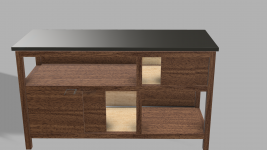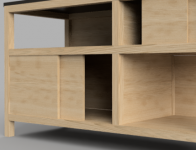My sister asked me about making a piece of furniture which could support a soapstone countertop. I think it will be around 5' wide, 20" deep. Google tells me this is around 160 lbs. The piece will probably end up looking like some kind of mid-century or modern style credenza.
However, I'm not really sure what additional engineering I need to consider for supporting the extra weight of a stone top.
For example, let's say I am designing the legs of this thing. Am I asking for trouble if I don't place the legs at or near the outside corners? Will the weight of the slab cause any issues?
Any sagging concerns I might want to think about? I assume it's a rigid and distributed weight, but 32lbs per linear foot is still a fair bit.
Should I be planning to support the underside of the top as fully as possible? Is a cantilever a bad idea? Would frameless construction be problematic in this case?
Any ideas, tips, insights, or experiences would be greatly appreciated!
However, I'm not really sure what additional engineering I need to consider for supporting the extra weight of a stone top.
For example, let's say I am designing the legs of this thing. Am I asking for trouble if I don't place the legs at or near the outside corners? Will the weight of the slab cause any issues?
Any sagging concerns I might want to think about? I assume it's a rigid and distributed weight, but 32lbs per linear foot is still a fair bit.
Should I be planning to support the underside of the top as fully as possible? Is a cantilever a bad idea? Would frameless construction be problematic in this case?
Any ideas, tips, insights, or experiences would be greatly appreciated!








